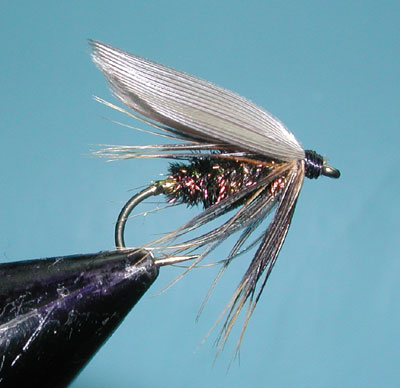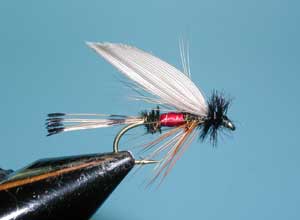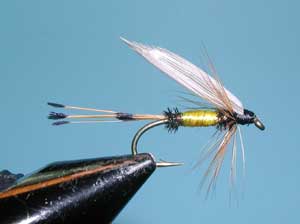Notes: The Leadwing Coachman finds it's origins in the early 1820's as an offering from a carriage driver, Tom Bosworth, to his English Lord for fishing. The original Coachman fly was a wet pattern of a peacock herl body, white duck quill wing, and brown throat hackle. Although wet flies found much interest during the early 1900's, they seem to have lost favor with most flyfishermen. The Leadwing Coachman can still be an effective fly, today. The wings were switched to a pair of Gray Mallard slips and a Gold wire tag was added to the rear of the body. The Peacock Herl body has proven to be popular as an atttractor with many patterns from the Zug Bug to the Prince Nymph. The best use for the Leadwing Coachman is during gray caddisfly hatches, particularly when the dry flies seem to be ineffective. The Leadwing looks like diving caddis laying their eggs on the bottom of the trout stream.
Other variations from this pattern include the Royal Coachman and the California Coachman. The Royal Coachman was first tied commercially by John Haily of New York in 1878 while he was employed by the Orvis Company and is probably the most recognized fly in the world. Mr. Haily received the prototype of the Royal Coachman from another tyer. The tyer was concerned that the peacock body was too frail and red silk in the middle was suggested to make the pattern more durable. Some Wood Duck fibers were also suggested for the tail. Mr Haily incorporated the changes but replaced the Wood Duck fibers with Golden Pheasant Tippet. After these changes were made, the pattern was recognized as the Royal Coachman. According to John Haily, "A gentleman wanted me to tie some Coachman for him to take up into the north woods, and to make them extra strong, so I have tied them with a little bank of silk in the middle, to prevent the peacock bodies from fraying out. I have also added a tail of the barred feathers of wood-duck, and I think it makes a very handsome fly." A few evenings later, a circle of us were together "disputing the fly question," one of the party claiming that numbers were "quite suitable to designate the flies as so many nonsensical names." The others did not agree with him, but he said: "What can you do? Here is a fly intended to be a Coachman, yet it is not the true Coachman; is quite unlike it, and what can you call it?" Mr. L.C. Orvis, brother of Mr. Charles Orvis, who was present, said: "Oh, that is easy enough; call it the Royal Coachman, it is so finely dressed!" And this name in time came to be known and used by all who are familiar with the fly." Credits: Quoted text from Favorite Flies and Their Histories, by Mary Orvis Marbury, published by The Lyons Press.
The California Coachman was designed by Mr. J.W. Fricke of San Francisco in the early 1900's and was published in A. Courtney Williams book, "Trout Flies" in 1932. It merely substituted the colors of the silk floss middle from red to yellow. Most of these patterns had a later dry fly version using a catskill style. |




